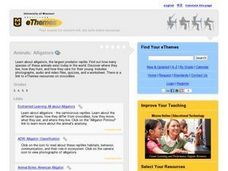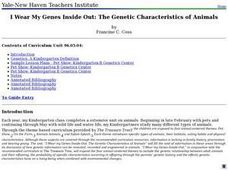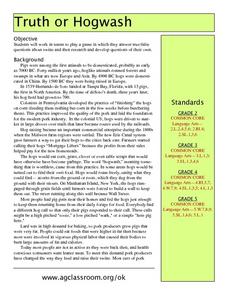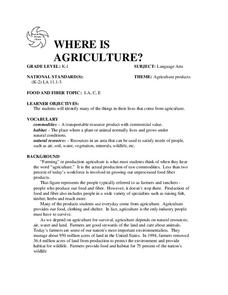Curated OER
Animals: Alligators
Students study alligators, discover their habitats, species and how they care for their young.
Curated OER
I Wear My Genes Inside Out: The Genetic Characteristics of Animals
Students create mixed breed dogs using paper illustrations of various breeds. They label dogs created by students using the Genetics Center and discuss the aspects of genetics that affect the outcome of the various projects.
Curated OER
Our Class Band
Students play percussion instruments that have been divided into four groups and perform to 'Old MacDonald Had a Farm'. In this percussion performance lesson, students identify percussion instruments divided into four categories....
Curated OER
Food and Fiber: Helping the Environment and You
Fourth graders explore the many uses of corn-based products and the importance of water resources. They consider how biodegradable products help to keep water clean. They perform experiments to observe how corn pellets dissolve while...
Curated OER
Biosecurity Keeps Everyone Safe
Students evaluate websites and determine whether they are valid or invalid resources regarding the topic of infectious diseases and animals. They explore a variety of websites, write a research paper about biosafety, and complete a...
Weston Wood
Joseph Had a Little Overcoat
Create a cross-curricular learning experience based on the children's book Joseph Had a Little Overcoat with this collection of learning activities. Starting with a class reading of the story, children go on to learn about the...
Curated OER
LET YOUR FINGERS DO THE WALKING
The student will recognize different information sources. 2. The student will use a telephone book as a resource for locating agricultural businesses
and people with agriculture-related jobs.Discuss the purpose of the phone book, and...
Curated OER
The Cox and Gossner Family Histories
Eleventh graders investigate the relationship between physical geography and Utah's settlement , land use, and economy. In this Geography lesson, 11th graders examine the interrelationship between Utah's climate. Students...
Curated OER
Heartfelt/Handmade Activities: Genre Painting
Students examine genre painting. They explore the Illinois State Museum website, identify how genre paintings were composed, analyze the activities of an Illinois farm in the 1850s, and create a genre painting of current everyday...
Curated OER
The Long Road to Coffee
Students organize picture cards of the sequene of how food gets from a farm to their home. They then sequence cards of how coffee grown in Colombia gets to their home comparing the differences.
Curated OER
Space Age Technology Comes to Earth
Students explore jobs related to agriculture. In this technology/agriculture lesson, students recognize the importance of natural resources and agriculture on the use of Range Rambler software. Students complete an experiment and a...
Curated OER
Reptile and Amphibian Defense Strategies
Young scholars study the stages of the Eastern newt either by collecting a live specimen or from pictures. They note the colors of the eft stage before reading the "Eastern Newt Species Account" that shows the newt's life stages,...
Curated OER
Have and Have-Not
Students describe the differences of people living in developed and underdeveloped countries. They also identify how each type of country uses their resources. They develop an ecological footprint of the countries discussed.
Curated OER
Truth or Hogwash
Explore the history of domesticated pigs and their important byproducts. After discussing the use of pigs, class members create game boards describing the animals. While playing the game, they determine if the answers are true or...
Curated OER
WHERE IS AGRICULTURE?
The students will identify many of the things in their lives that come from agriculture.See if someone involved in production agriculture will "adopt" your class. Students can correspond with the farmer or rancher's family. This will...
Curated OER
You Are The Farmer
Students investigate the farming business and occupations in agriculture. Basic multi-step math operations are performed in calculating some of the expenses involved in farming.
Curated OER
Wild Dog Debate
Students participate in a mock conference addressing the possible extinction of African wild dogs. In this wild dogs lesson plan, students state their arguments and ask questions about the issues they have researched.
Curated OER
Representing and Extending Patterns
Students explore repeating and growing patterns. In this patterns lesson, students describe patterns, explore changing patterns and match patterns. Students participate in online activities and read books that show patterns in...
Curated OER
Science Egg Experiment
Students examine and hypothesize about hard cooked and raw eggs before experimenting to see which one cracks more easily when dropped in a bucket. They open both eggs and compare them using a Venn diagram. They design a presentation...
Curated OER
They Don't Just Eat Grass
Students consider the USDA daily recommendations to create a "feed" product for middle schoolers. In this Health lesson, students learn about the ingredients in feed that is fed to livestock and apply the method to creating feed rations...
Curated OER
Pets
Students participate in an after school program that promotes making decisions, getting along with others, decision-making, and being responsible. A pet survey is administered along with a variety of pet riddles with the students. They...
Curated OER
They Don't Just Eat Grass
Middle schoolers explore and examine different types of feed used for livestock. They discuss types of feed, the need for energy and health, and create graphs of food compared to categories. Students organize data and complete worksheets...
Alabama Learning Exchange
Dancing to New Heights
Pupils identify proper body alignment through experiencing proper sitting, standing or prone positions. They identify and demonstrate different types of movements.
Curated OER
Where it Grows
First graders identify the commodities of Oregon and produce a map of the different commodities in different regions.

























